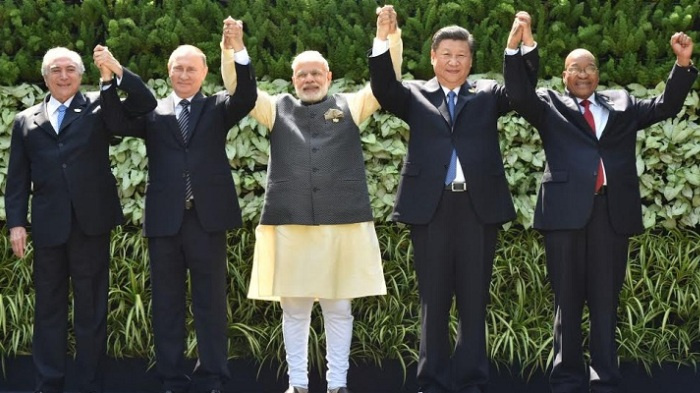Goha Summit Stabilizes the BRICS

The 8th Summit of BRICS -- Brazil, Russia, India, China and South Africa -- in Goha, India, took place on October 15-16 and was, by all indications, a relatively successful summit to maintain the momentum for intra-BRICS cooperation and sustaining its tangible, albeit modest, achievements. The initial euphoria about BRICS, as an alternative to the Western-dominated global institutions, has faded but the group’s member-states remain committed to scaling up their engagements, consolidating their past institutional progress and charting a sustainable path of economic revival for the group -- that comprises of 43% of the world’s population, having 30% of the world’s GDP, and 17% of the world’s trade.
With Russian, Brazilian, and South African economies on the economic skids, China slowing, and global protectionism on the rise, this was a crucial summit that reaffirmed BRICS’ relevance, thus quieting the critics, assuming that BRICS can in the future fulfill some of its key objectives, such as doubling the inter-BRICS trade by 2020 (at present the volume of inter-BRICS trade stands at about 250 billion US dollars). According to President Jacob Zuma of South Africa:
“A lot of progress has been made in recent times. These include the implementation of the Strategy for the BRICS Economic Partnership, the operationalisation of the New Development Bank and the BRICS Contingent Reserve Arrangement, the BRICS Export Credit Agencies discussions on insurance and underwriting, the exploration of a BRICS Rating Agency; and the hosting of the first BRICS Trade Fair.”
As expected, each country brought its own agenda to the summit, e.g. Russia’s President Putin succeeded in beating the Western insistence on his global isolation and in inserting his Syria objectives in the final Goha Declaration, and India sought to broaden its regional reach by organizing a joint meeting of BRICS and the Bay of Bengal Initiative for Multi-Sectoral Technical and Economic Cooperation (Bimstec) comprising Bangladesh, Bhutan, Myanmar, Nepal, Sri Lanka and Thailand. Still, India’s Prime Minister Narendra Modi was unable to achieve all he wanted, such as on India’s inclusion in the Nuclear Suppliers Group or the inclusion of Pakistan-based terrorist groups in the final communiqué, partly due to the Russian and Chinese objections, thus raising the ire of Indian media (Times of India lamented that the Summit failed to reflect “India’s core concerns about the threat of state-sponsored terrorism.”) India is nervous about Russia’s recent military exercise with Pakistan, although Putin reassured India that it has “no hostile intentions,” indeed an important prerequisite for the growing Russia-India economic ties, particularly in the energy field.
Although divergent geopolitical interests preclude the BRICS’s rise as a potential security arrangement, on “geo-economics” it is destined to play a growing role, particularly if its newly-established development bank succeeds in meeting its objectives, which in turn require a substantial increase in its current asset of 100 billion US dollars; the projected objective is to raise this to one trillion US dollars. With respect to the New Development Bank, it has now established a regional center in Africa, and has begun to disperse loans on green projects as well as infrastructural projects. BRICS’s other initiative, the Contingent Reserve Arrangements, is seeking to strengthen the global financial safety net. With the help of its subsidiary arm, BRICS Business Council, the group is seeking to enhance collaboration for facilitating procedures for customs control, tariff reductions, and the like, which is key to enhance inter-BRICS trade. This summit’s biggest success was perhaps in sending the important signal to the world that despite the internal turmoil of some members and the wealth of their divergent interests, the BRICS countries remain united on the path of cooperation and their shared interests for a more equitable world economy are also shared by a large number of other developing nations, who look to BRICS for both inspiration and leadership in today’s turbulent global politics.

